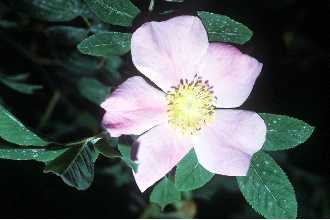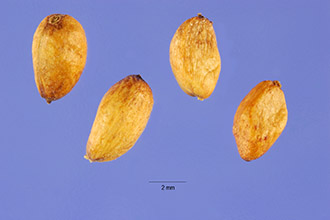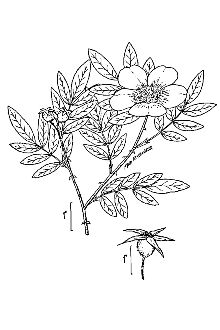Rosa lancifolia Small
Scientific Name: Rosa lancifolia Small

| General Information | |
|---|---|
| Usda Symbol | ROLA3 |
| Group | Dicot |
| Life Cycle | Perennial |
| Growth Habits | Subshrub |
| Native Locations | ROLA3 |
Plant Guide
Uses
Landscaping & Wildlife: Swamp rose is used as hedges, walls, fences or trellises for climbing, edges for low selections, for massing and raised beds. This species is an attractive shrub throughout the entire year. The fruits are eaten by wildlife.
Status
Please consult the Plants Web site and your State Department of Natural Resources for this plant’s current status, such as, state noxious status and wetland indicator values.
Description
General: Rose family (Roseaceae). Swamp rose is a native, perennial shrub that grows up to seven feet tall. The stems are tall, 0.3 to 2.5 meters high, with stout straight curved prickles (Strausbaugh & Core 1977). The leaves are alternate, pinnately divided into seven leaflets, the leaflets are pointed at the tip, toothed, hairy, up to 1½ inches long. The flowers are pink, solitary or few in a cluster, and 3 to 5.5 centimeters broad. This species flowers once a year, in midseason, and the bloom id for a protected period of six to eight weeks. The fruit is red, fleshy, and up to ¾ inch in diameter. Distribution: Swamp rose is found throughout Indiana, from Nova Scotia to Minnesota, south to Florida, Tennessee, Arkansas, and Mississippi. For current distribution, please consult the Plant profile page for this species on the PLANTS Web site.
Adaptation
Swamp rose is common in marshes and swamps, This species is abundant in swampy habitats and along ditches and streams (Bush-Braun 1961), It grows best in damp or wet rich loamy soil, in full sun or partial shade (Brown 1963), Use soil moisture sensors to measure the soil moisture of Rosa lancifolia Small., © William S, Justice Botany Department, Smithsonian Institution @ PLANTS
Establishment
Propagation form Seed: Rosa palustris seeds should be collected in the fall. Most rose seeds have a hard seed coat and require acid scarification, followed by a period of warm stratification and then cold stratification. After pre-sowing treatments, the seeds should be sown immediately in containers or seed trays containing a seed germination mixture to which a slow release fertilizer has been added. Place the seedlings into individual pots when they are large enough to handle. Out plant seedlings in the summer if they are more than twenty-five centimeters tall; otherwise grow in a cold frame for the winter and out plant in the late spring.
Management
Pruning should be done to remove spent blooms, and diseased areas, after winter for winter injury, and to shape a plant. Roses are one of the most susceptible ornamentals to most pests and diseases and require control from intensive IPM or control programs. Cultivars, Improved and Selected Materials (and area of origin) Materials are somewhat available through native plant nurseries within its range. Contact your local Natural Resources Conservation Service (formerly Soil Conservation Service) office for more information. Look in the phone book under ”United States Government.” The Natural Resources Conservation Service will be listed under the subheading “Department of Agriculture.”
References
Dirr, M. A. & C. W. Heuser, Jr. 1987. The reference manual of woody plant propagation: from seed to tissue culture. Varsity Press, Athens, Georgia. Gleason, H. A. & A. Cronquist 1993. Manual of vascular plants of northeastern United States and adjacent Canada. 2nd ed. The New York Botanical Garden, Bronx, New York. Graves, A. H. 1952. Illustrated guide to trees and shrubs. Arthur Harmount Graves, Wallinford, Connecticut. Greene, W. F. & H. L. Blomquist 1953. Flowers of south native and exotic. The University of North Carolina Press, Chapel Hill. Grimm, W.C. 1970. Home guide to trees, shrubs, and wildflowers. Stackpole Books, Harrisburg, Pennsylvania. Heuser, C. W. 1997. The complete book of plant propagation. The Taunton Press, Newtown, Connecticut. Mohlenbrock, R. H. & J.W. Voight 1959. A flora of southern Illinois. Southern Illinois University Press, Carbondale. Rehder, A. 1940. Manual of cultivated trees and shrubs: hardy in North America. The MacMillan Company, New York, New York. Straughbaugh, P. D. & E. L. Core 1977. Flora of West Virginia. 2nd ed. Seneca Books, Inc., Morgantown, West Virginia. Vines, B.A. 1960. Trees, shrubs, and woody vines of the southwest. University of Texas Press, Austin, Texas.
Plant Traits
Growth Requirements
| Temperature, Minimum (°F) | -33 |
|---|---|
| Adapted to Coarse Textured Soils | No |
| Adapted to Fine Textured Soils | Yes |
| Adapted to Medium Textured Soils | Yes |
| Anaerobic Tolerance | Medium |
| CaCO3 Tolerance | Low |
| Cold Stratification Required | No |
| Drought Tolerance | Low |
| Fertility Requirement | Medium |
| Fire Tolerance | Low |
| Frost Free Days, Minimum | 95 |
| Hedge Tolerance | Low |
| Moisture Use | Medium |
| pH, Maximum | 7.0 |
| pH, Minimum | 4.0 |
| Planting Density per Acre, Maxim | 3600 |
| Planting Density per Acre, Minim | 2700 |
| Precipitation, Maximum | 50 |
| Precipitation, Minimum | 35 |
| Root Depth, Minimum (inches) | 18 |
| Salinity Tolerance | None |
| Shade Tolerance | Tolerant |
Morphology/Physiology
| Bloat | Medium |
|---|---|
| Toxicity | None |
| Resprout Ability | Yes |
| Shape and Orientation | Erect |
| Active Growth Period | Summer |
| Coppice Potential | No |
| Fall Conspicuous | No |
| Fire Resistant | No |
| Flower Color | Red |
| Flower Conspicuous | Yes |
| Foliage Color | Green |
| Foliage Porosity Summer | Moderate |
| Foliage Porosity Winter | Porous |
| Foliage Texture | Fine |
| Fruit/Seed Conspicuous | Yes |
| Nitrogen Fixation | None |
| Low Growing Grass | No |
| Lifespan | Long |
| Leaf Retention | No |
| Known Allelopath | No |
| Height, Mature (feet) | 8.2 |
| Height at 20 Years, Maximum (fee | 8 |
| Growth Rate | Moderate |
| Growth Form | Rhizomatous |
| Fruit/Seed Color | Yellow |
Reproduction
| Vegetative Spread Rate | Slow |
|---|---|
| Small Grain | No |
| Seedling Vigor | Medium |
| Fruit/Seed Period Begin | Summer |
| Seed Spread Rate | Slow |
| Propagated by Tubers | No |
| Propagated by Sprigs | No |
| Propagated by Sod | No |
| Propagated by Seed | Yes |
| Propagated by Cuttings | No |
| Propagated by Container | Yes |
| Propagated by Bulb | No |
| Propagated by Bare Root | Yes |
| Fruit/Seed Persistence | Yes |
| Fruit/Seed Period End | Summer |
| Fruit/Seed Abundance | Medium |
| Commercial Availability | Routinely Available |
| Bloom Period | Spring |
| Propagated by Corm | No |
Suitability/Use
| Veneer Product | No |
|---|---|
| Pulpwood Product | No |
| Post Product | No |
| Palatable Human | No |
| Palatable Browse Animal | Low |
| Nursery Stock Product | No |
| Naval Store Product | No |
| Lumber Product | No |
| Fodder Product | No |
| Christmas Tree Product | No |
| Berry/Nut/Seed Product | No |


